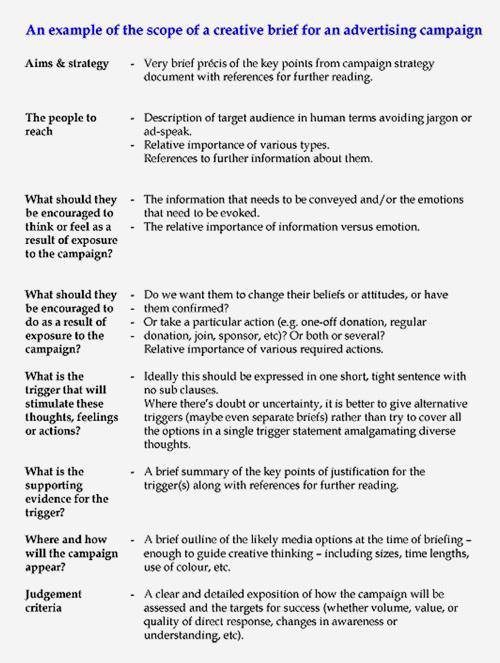It’s hard work being a client these days. Part 2
- Written by
- Andrew Papworth
- Added
- May 15, 2013
Part 2 – getting down to detail
Armed with the information in the brand book outlined in part one and stimulated by the process of putting it all together, it will be far easier to write an effective strategy for any campaign by concentrating on the essential issues.
- Defining objectives precisely.
- Outlining strategies.
- Defining the priorities for responses.
- Summarising the key relevant aspects of behaviour, perceptions and attitude among the target sources of response.
- Summarising the key strengths and weaknesses of the charity’s offering in the context of the market and how the charity’s offering compares with its closest competition and in particular where it has a distinctive edge.
- The precise role of advertising in the marketing mix.
- How its effectiveness will be measured.

Clearly, the more comprehensive the brand book is the easier it will be to call on the necessary information to define the strategy in a lean, succinct and relevant way without waffle. The curse of such documents is that they often tend to include the kitchen sink for fear of missing out something important. If the recipients of briefs know they can see the whole story and the answers to any detailed questions they may have in the brand book, it makes it possible to restrict the campaign strategy documents to just the most relevant elements and to concentrate minds on the specific task.
This is even truer of creative and media briefs. The aim when writing a creative brief ought to be to get the essentials on to a single side of A4 so that it can be pinned on the wall by the team working on it. But every word must count. By all means refer to the brand book for further information but the ideal brief brings the task down to a few simple sentences.
Every organisation will have its own way of doing these things but the essentials can be seen in the example left (although the headings may well be expressed differently).
All the nuts and bolts, such as the information to be included in any coupon or reply form; response addresses, telephone numbers, etc; mandatory information to be included; timing plan for the work; corporate ID or campaign style essentials; budget/production restrictions, etc, should be attached to this simple document, or on the reverse.
Where it is at all feasible, access should be given to creative teams to meet people other than marketing and fundraising staff in the charity for them to be able to see for themselves how the charity works and to ask questions. At the very least literature and films about the charity’s work should be provided. A written brief is rarely enough on its own. Everything that can be done to make the creative team understand how the charity ticks will pay dividends.
A media brief should cover much of the same ground but will need to spell out the budget and timing in greater detail and will need to supplement the description of the target audience with enough demographic data to allow media targeting and comparative evaluations. If it’s a brief for a ‘hearts and minds’ campaign it will need to specify the relative importance of coverage, frequency and continuity. If it’s a brief for a direct response campaign it must be supplemented with full response data from past campaigns giving as much guidance as possible about media choice, sizes/lengths, position, timings, spacing and repetition, etc. It should also have information about the importance and feasibility of snatch buying and deep discounting and any special requirements such as split runs or the use of specialist supplements.
Above all, it is vital that briefs are not restrictive. They should be written to stimulate fresh thinking and not to direct thinking along restrictive tramlines. Briefs must not be so broad and vague as to allow anything nor must they be so restrictive that the outcome is utterly predictable. The skill in writing a good brief is expressing it in a way that encourages relevant lateral thinking and allows for the surprising.

As the diagram shows, everything springs from having a comprehensive and authoritative brand book.
Finally, it will fall to the charity marketer these days to encourage communication and co-operation between various suppliers – performing the roles of the old-style agency account director and planner recalled in part one. It is particularly important to encourage feedback between the creative team and the media planner. Because of the current tendency to disperse work among several suppliers it can be tempting to make media decisions very early in the process along the lines of ‘we need a TV campaign using 60-second spots’; or ‘we need some loose inserts following our usual format’ and to allocate budgets accordingly. This can easily be set in concrete and stifle the flexibility necessary to produce change and innovation.
Treat the creation of a brand book as an adventurous voyage of discovery for you – and maybe a project team – and it will repay the effort many times over. Set a reasonable timetable that allows you to do justice to the task but not so long that it becomes a never-ending chore. If there are gaps it is better to publish what you have and make the best of it rather than wait for perfection. Good luck.


















